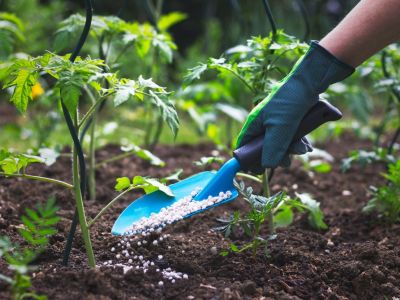As the weather begins to warm, many gardeners wonder what fertilizer to use in spring, and when to fertilize garden plants. The best fertilizer for spring can be determined accurately by using a soil test. This will tell you what nutrients and minerals might be lacking in your soil. Each plant’s needs vary, so it is also important to know the nutrient requirements of specific varieties.
When to Fertilize in Spring
As soil temperatures begin to increase, plants start to actively grow after a dormant period. Plants should be fed when they are dormant, or at least when they are not under any stress, such as extreme heat. For plants like sod grasses, it is best to wait until they are actively growing but adequate moisture is available. For all plants, fertilizer should be worked into the soil, or a liquid fertilizer applied. Plants like perennials rarely need food. In some instances, applying too much will result in leggy plants. Garden soil should be prepared as soon as it is workable by working in a time release, granular food for slow uptake and continuous feeding of plants like vegetables and ornamentals.
About Spring Fertilizer
Garden soil may contain all the nutrients plants require, but over time the nutrients are used and need to be replaced. If the soil has organic amendments added continuously, it may be rich enough without fertilizer. The only way to be sure is a soil test. These can be purchased at nurseries and other plant centers, or the soil may be collected and sent away to local Extension offices for analysis. It is important to know soil pH as well. An acidic soil will benefit from an application of lime prior to fertilizing. The lime will neutralize the soil, allowing plants to better intake nutrients. For most plants, a healthy pH is between 6.0 and 7.0. Lower numbers indicate acidic soil which reduces a plant’s ability to access nutrients.
What Fertilizer to Use in Spring
The best fertilizer for spring will vary by plant species. For instance, plants like Rhododendrons prefer acidic soil. Therefore, a formula made for such plants will enhance their growth. All purpose fertilizers provide the basic nutrients and minerals most plants need and are a good option in many cases. Lawns need higher levels of nitrogen than blooming plants. The numbers on the fertilizer will determine the levels of each nutrient. The first number is nitrogen, the second is phosphorus, and finally, potassium. Natural fertilizers like leaf litter, compost, bonemeal, and wood ash can also provide plants’ basic needs. A combination of organic and synthetic fertilizers is useful when large amounts of organic material are difficult to access.
